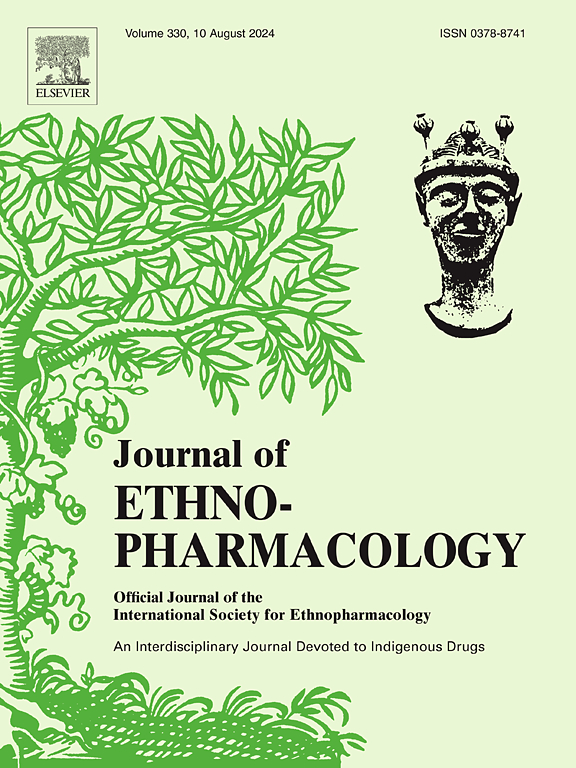揭示虎葛治疗胃癌的有效生物活性化合物和抗血管生成途径。
IF 4.8
2区 医学
Q1 CHEMISTRY, MEDICINAL
引用次数: 0
摘要
民族药理学相关性:壁虎(Gekko swinhonis Guenther),在下文中通常被称为壁虎,属于壁虎科中的壁虎属。其干全身是一种被广泛应用的中药,在治疗胃肠道恶性肿瘤,特别是胃癌(GC)方面具有显著的疗效。然而,壁虎的成分是复杂的,需要进一步研究其有效成分,以治疗气相色谱。目的:基于壁虎抗gc抑制血管内皮细胞和抗新生血管的机制,对壁虎中最有效的活性成分进行分离和鉴定。材料和方法:利用壁虎的酶解物研究其有效性和作用机制。首先,我们评估了其在异位和原位胃癌小鼠模型中的疗效。随后,我们使用CCK-8和3D肿瘤球体测定法评估了从壁虎中提取的肽、脂肪和小分子的有效性。通过这些实验进一步检测了肽S1-S4的活性。最后,我们在CCK-8实验和原位GC模型小鼠中筛选、合成并研究了5种潜在肽的药效学。结果:壁虎能抑制肿瘤微环境中血管的形成,为胃癌提供了一种局部治疗方法。肽组分显著抑制血管内皮细胞并阻碍新血管的形成,其中S2肽段(0.3 KD - 3kd)对血管生成的抑制活性最强。其中一种活性肽通过抑制血管生成有效抑制裸小鼠原位GC的生长,并调节免疫,同时具有良好的生物安全性。结论:我们在壁虎局部治疗胃癌方面取得了重大突破。通过药理学实验和系统的分离鉴定过程,我们根据其抑制血管内皮细胞和促进抗血管生成的机制,确定了壁虎中最有效的抗gc成分。此外,我们还合成了一种具有良好疗效和安全性的先导肽。本文章由计算机程序翻译,如有差异,请以英文原文为准。

Unveiling potent bioactive compounds and anti-angiogenic pathways in Gekko swinhonis Guenther for gastric cancer therapy
Ethnopharmacological relevance
Gekko swinhonis Guenther, commonly referred to as Gecko in the following text, belongs to the genus Gekko within the family Gekko. Its dried whole body is a widely utilized traditional Chinese medicine, demonstrating significant efficacy in the treatment of gastrointestinal malignancies, particularly gastric cancer (GC). Nevertheless, the composition of the gecko is complex, necessitating further research into its active ingredients for the treatment of GC.
Aim of the study
Isolation and characterization of the most active components in Gecko based on their anti-GC mechanisms of vascular endothelial cell inhibition and anti-neovascularization.
Materials and methods
We utilized the enzymatic hydrolysate of Geckos to investigate its effectiveness and underlying mechanisms. Initially, we assessed its efficacy in ectopic and in-situ GC tumor-bearing mouse models. Subsequently, we evaluated the effectiveness of peptides, aliphatics, and small molecules derived from Gecko using CCK-8 and 3D tumor spheroid assays. The activities of peptides S1-S4 were further examined through these experiments. Finally, we screened, synthesized, and investigated five potential peptides for their pharmacodynamics in the CCK-8 assay and in the in-situ GC model mice.
Results
The Gecko can inhibit the formation of blood vessels in the tumor microenvironment, providing a localized treatment for GC. The peptide components significantly inhibit vascular endothelial cells and impede the formation of new blood vessels, with the S2 peptide sections (0.3 KD - 3 KD) demonstrating the most potent inhibitory activity against angiogenesis. One of the active peptides effectively suppresses the growth of in-situ GC in nude mice through angiogenesis inhibition and also modulates immunity, all while exhibiting excellent biosafety.
Conclusions
We have achieved a significant breakthrough in the local treatment of GC using Gecko. Through pharmacodynamic experiments and a systematic process of isolation and identification, we identified the most effective anti-GC ingredients of Gecko, based on their mechanisms of inhibiting vascular endothelial cells and promoting anti-angiogenesis. Furthermore, we synthesized a lead peptide that demonstrates promising therapeutic efficacy and safety.
求助全文
通过发布文献求助,成功后即可免费获取论文全文。
去求助
来源期刊

Journal of ethnopharmacology
医学-全科医学与补充医学
CiteScore
10.30
自引率
5.60%
发文量
967
审稿时长
77 days
期刊介绍:
The Journal of Ethnopharmacology is dedicated to the exchange of information and understandings about people''s use of plants, fungi, animals, microorganisms and minerals and their biological and pharmacological effects based on the principles established through international conventions. Early people confronted with illness and disease, discovered a wealth of useful therapeutic agents in the plant and animal kingdoms. The empirical knowledge of these medicinal substances and their toxic potential was passed on by oral tradition and sometimes recorded in herbals and other texts on materia medica. Many valuable drugs of today (e.g., atropine, ephedrine, tubocurarine, digoxin, reserpine) came into use through the study of indigenous remedies. Chemists continue to use plant-derived drugs (e.g., morphine, taxol, physostigmine, quinidine, emetine) as prototypes in their attempts to develop more effective and less toxic medicinals.
 求助内容:
求助内容: 应助结果提醒方式:
应助结果提醒方式:


